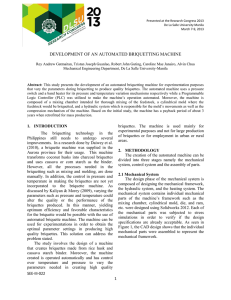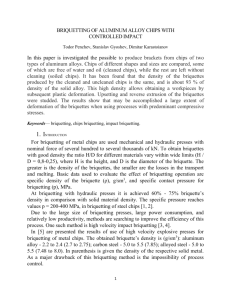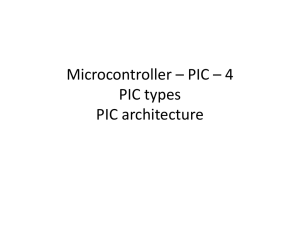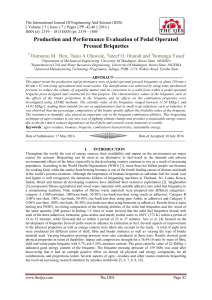Research and optimization processes of briquetting for ecological
advertisement
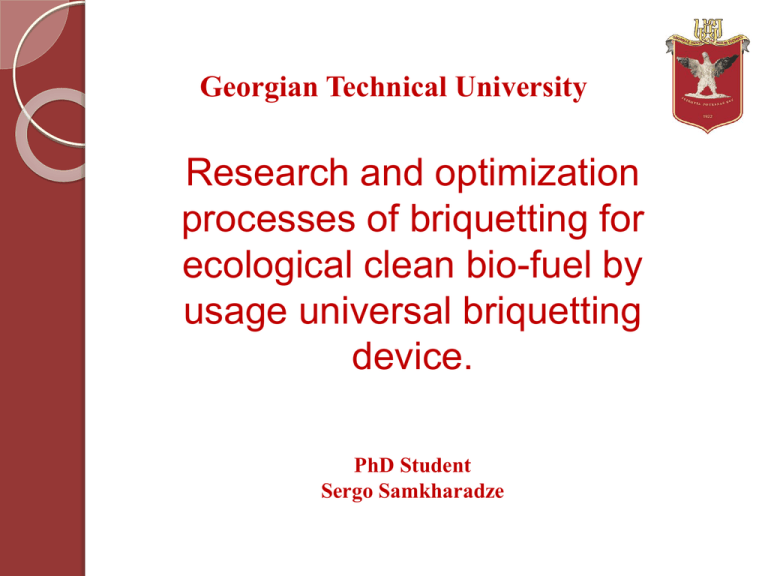
Georgian Technical University Research and optimization processes of briquetting for ecological clean bio-fuel by usage universal briquetting device. PhD Student Sergo Samkharadze 1. Introduction The large scale use of commercial energy has led to better quality of life; however it has also created many problems. Perhaps the most serious of these are the harmful effect on the environment and climate changes which both have consequences on human health and pollution. Also it is now clear that the fossil fuel era of nonrenewable resources is gradually coming to an end. Energy problem is very serious and the main objective is now to find solution to match demand and supply of energy sources. Therefore the need for conserving energy and developing alternative energy is a must. 2. Economical and ecological effect By Georgian technical university was assessed situation on the world - as well on Georgian energy market and was decided to make high quality bio-briquettes (pic.1) by using local raw materials such are a wood sawdust, agricultural wastes etc. Pic. 1. Sawdust briquette. Bio-briquettes are characterized with high heat emission, longevity of burning process, low ash content and ecological compatibility. Briquette parameter Briquette density, t/m³ Ash content, % CO2 emission Sulfur emission,% Value 1,0 – 2,0 0,5 – 1,5 50 times less than coal; 15 times less than natural gas; 0,032 Sawdust briquette after the burning, emits into atmosphere 50 times less CO2 than coal and 15 times less CO2 than natural gas. Sulfur emission into the atmosphere is 0,032%, which practically doesn’t contaminate atmosphere. 3. Energetically values. Below we can see heat content chart for mostly used fuels to present. Fuel type Heat content kcal/kg Wood (Wet) 2388 Wood (Dry) 2866 Sawdust Briquettes 4300 Black coal 4770 Natural gas 7640 We can easily calculate power output (1) and burning rate (2) value for each type of fuel. (1) (2) 4. Equipment To reach the high quality of product from us was investigated briquetting process parameters. Mostly bio-briquette quality is depended from two parameters, such are moisture and raw material particle size. Pic. 2 Raw material particles and moisture meter In Georgian Technical University experimentally we had developed universal equipment (press) construction for briquetting of bio-fuel. The aim of the creating new briquetting device was that it had worked in maximum range for these parameters, also to be have good durability condition against big forces, internal and external frictions as well it should be safe for works, easy to maintenance and etc. Pic. 3 Slogan of the equipment Pic. 4 Scheme of briquetting device When we are making briquettes from raw material which consist of different size particles or moisture in range 8-14%, we couldn’t convinced when we need big forces and when much less forces for briquetting. Because we was forced to create some simple test to understand regime parameter correctness. Principe of test is very simple, but it can gave us understanding in main technological aspect - has product high quality or not. Pic. 5 Scheme of compression 1 - compression plate, 2 – briquette, 3 – support plate 5. Future investigation The big amounts of biomass that are expected to be produced in the upcoming future will require appropriate machinery, transport systems and storage facilities to handle it. Different biomass materials (or even different grades of the same material) can have very different properties. Thus, different handling, transport and/or storage solutions would be required. Advanced numerical techniques such as the finite element method (FEM) may be used to analyse the behaviour of biomass for storage and transport in order to avoid problems in the industries such as blockages or damages in the machinery and equipments. Looking forward to the future, with cooperation FZJ exactly central technology division (ZAT), we hope that we can grow and exchange knowledge in advance calculation methods. Now we are trying to simulate our products to investigate our experimental equipment stability, safety to increase our production and equipment quality. Below we can see briquette examples simulated in the Ansys; Pic. 6 Misses stress by parabolic hexahedron mesh (HR20) 6.Touch points with FZJ For us is known that in FZJ central technology division have big experience in designing, calculation, engineering and building different kind of equipment. For us will be big pleasure to cooperate with central technology division significant by exchanging our knowledge and experience. We will be happy to make participation in project which will Includes task such has our work (FEM calculation, safety design, standardization, etc). One of these project may be ,,Development of a standardized method to analyze the safe housing and its stability of fast rotors’’, which is currently actual in central technology division. Last year with support Georgian technical university we had participated to preparation above described project. Below we can see examples of our work in Ansys which was created our stay in FZJ. Pic. 7 Chopper disk crashing test Thank You for Attention!
